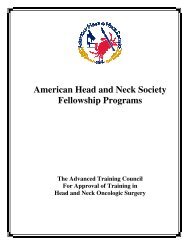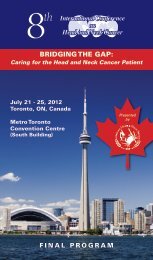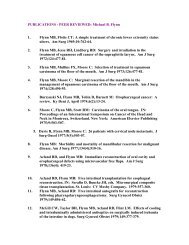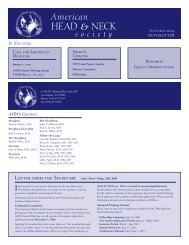Download - American Head and Neck Society
Download - American Head and Neck Society
Download - American Head and Neck Society
Create successful ePaper yourself
Turn your PDF publications into a flip-book with our unique Google optimized e-Paper software.
Oral Papers<br />
the 3’UTR of messenger RNA (mRNA), causing translational repression<br />
or degradation. To better underst<strong>and</strong> the potential role of miRNA in<br />
HNSCC carcinogenesis, miRNA-21 specific gene targets were identified<br />
<strong>and</strong> their expression signatures were assessed utilizing the power of<br />
microarray technology <strong>and</strong> bioinformatics miRNA target prediction<br />
tools. Design: Whole genome mRNA expression was analyzed by<br />
microarrays in HNSCC tumors, normal mucosa <strong>and</strong> a normal oral<br />
keratinocyte cell line (NOK-SI) transiently overexpressing miRNA-21. A<br />
c<strong>and</strong>idate list of miRNA-21 gene targets was generated by identifying<br />
common downregulated mRNA expression signatures in HNSCC<br />
tumors <strong>and</strong> the miRNA-21 overexpressing normal oral keratinocyte cell<br />
line. The c<strong>and</strong>idate target gene list was further narrowed by evaluating<br />
each 3’UTR region with bioinformatics tools for miRNA-21 specificity.<br />
Expression levels of miRNA-21 gene targets were determined by<br />
reverse transcription quantitative polymerase chain reaction (RTqPCR).<br />
Specificity of miRNA-21 for each c<strong>and</strong>idate gene target was<br />
assayed utilizing the luciferase miRNA target expression vector system.<br />
Subjects: Matched 13 HNSCC tumors <strong>and</strong> 5 normal mucosa total RNA<br />
samples, in addition to NOK-SI cell line RNA samples after triplicate<br />
miRNA-21 <strong>and</strong> mock lentiviral vector transient transfections were used<br />
for mRNA microarray analysis. Results: Microarray analysis combined<br />
with bioinformatics tools for miRNA-21 gene target prediction generated<br />
a c<strong>and</strong>idate gene list, including Clusterin, Basonuclin 2, <strong>and</strong> Desmin<br />
(FAM48a). Expression levels of miRNA-21 gene targets were significantly<br />
lower in HNSCC tumors <strong>and</strong> miRNA-21 transfected NOK-SI cell line<br />
when compared to normal mucosa <strong>and</strong> mock transfections by RTqPCR.<br />
Transfection of miRNA-21 significantly suppressed a luciferasereporter<br />
containing the 3’UTR of the miRNA-21 gene target verifying the<br />
specificity of miRNA-21 for the c<strong>and</strong>idate. Conclusions: Novel miRNA<br />
targets can be identified <strong>and</strong> validated utilizing an integrative approach<br />
with whole genome expression profiling <strong>and</strong> bioinformatics target<br />
prediction methods. MiRNA-21 has several mRNA targets in HNSCC <strong>and</strong><br />
further study is needed to evaluate their functional effects <strong>and</strong> possible<br />
use in detection, prognosis, <strong>and</strong> therapeutic outcome in HNSCC.<br />
S015<br />
AKT PHOSPHORYLATION AS A MARKER OF RESISTANCE TO<br />
ZD6474 (VANDETANIB) IN HEAD AND NECK SQUAMOUS CELL<br />
CARCINOMA. Genevieve A Andrews, MD, Mitchell J Frederick, PhD,<br />
Mei Zhao, MD, David R Fooshee, Zvonimir L Milas, MD, Maria K Gule,<br />
MD, Chad E Galer, MD, Jeffrey N Myers, MD PhD; MD Anderson Cancer<br />
Center.<br />
The epidermal growth factor receptor (EGFR) is an attractive target<br />
for anti-cancer therapy, in head <strong>and</strong> neck squamous cell carcinoma<br />
(HNSCC). Yet often HNSCC demonstrates resistance to EGFR inhibition.<br />
Therefore, drugs that target angiogenesis by inhibiting the VEGFR<br />
(vascular endothelial growth factor receptor) in addition to EGFR, such<br />
as ZD6474 (V<strong>and</strong>etanib), may be useful for treating HNSCC patients.<br />
To better underst<strong>and</strong> the mechanisms of resistance to EGFR inhibition,<br />
as well as examine biomarkers defining EGFR inhibitor resistance, we<br />
investigated the effect of ZD6474 in a panel of 50 HNSCC lines in vitro,<br />
where the principal in vitro drug effects are thought to be through the<br />
EGFR signaling pathway. The GI50 (50% growth inhibition) values for<br />
cell lines ranged from 0.4 µM to 14 µM between the most sensitive <strong>and</strong><br />
most resistant lines. When sensitive HNSCC cell lines FADU <strong>and</strong> PCI-13<br />
were treated for 30 hours with 4 µM ZD6474, there was more than a 70%<br />
reduction in the phosphorylation of AKT on Ser427. However, there was<br />
less than a 10% decrease in pAKT Ser427 observed for two resistant<br />
cell lines examined, SCC61 <strong>and</strong> JHU 028. There was a parallel reduction<br />
in constitutive pERK in the two sensitive cell lines following treatment<br />
with ZD6474 for 30 hours. The reduction in pERK only occurred in one<br />
of the resistant lines, SCC61. EGF-stimulated phosphorylation of the<br />
EGFR was similarly inhibited in both resistant <strong>and</strong> sensitive cells by 4 µM<br />
ZD6474, indicating that resistance was not due to a difference in drug<br />
target sensitivity in these cell lines. In conclusion, our preliminary data<br />
suggest a model wherein HNSCC cells sensitive to EGFR inhibition rely<br />
heavily upon the EGFR pathway to activate <strong>and</strong> maintain proliferation<br />
<strong>and</strong> survival mechanisms such as phosphorylation of AKT, whereas<br />
resistant cells may use other receptors or signaling molecules to activate<br />
critical downstream pathways to survive in the face of EGFR inhibition.<br />
www.ahns.info<br />
S016<br />
A BLOOD TRANSFUSION PREDICTION MODEL IN PATIENTS<br />
UNDERGOING MAJOR HEAD & NECK SURGERY INVOLVING FREE<br />
FLAP RECONSTRUCTION. Manish D Shah, MD MPhil FRCSC, David<br />
P Goldstein, MD FRCSC, Stuart McClusky, MD FRCPC, Patrick Gullane,<br />
MB FRCSC FACS FRACS Hon, Dale H Brown, MD FRCSC, Jonathan C<br />
Irish, MD MSc FRCSC FACS, Ralph W Gilbert, MD FRCSC; University<br />
Health Network, University of Toronto, Toronto, Canada.<br />
Objectives: Perioperative blood transfusion is commonly required<br />
for major head & neck procedures <strong>and</strong> carries significant risks.<br />
Alternatives to allogenic blood transfusion are becoming available.<br />
Pre-operative risk stratification of patients allows for appropriate<br />
patient counseling <strong>and</strong> resource allocation. Thus, the objective of our<br />
study was to develop a model to reliably predict the requirement for<br />
perioperative blood transfusion in patients undergoing major head <strong>and</strong><br />
neck surgery involving free flap reconstruction. Methods: Data was<br />
prospectively collected on all patients undergoing major head <strong>and</strong><br />
neck surgery requiring free flap reconstruction at the University Health<br />
Network (Toronto, Canada) between 1999 <strong>and</strong> 2009. Over 800 patients<br />
were included in the analysis. Pre-operative variables were tested for<br />
association with the outcome of interest, perioperative transfusion.<br />
Stepwise multivariable logistic regression modeling was carried out<br />
to determine which pre-operative variables were best able to predict<br />
perioperative transfusion requirement. Results: A predictive model<br />
of perioperative blood transfusion requirement was obtained from the<br />
logistic regression analysis. Six pre-operative variables were found to<br />
be significant—female gender (odds ratio [OR] = 4.1), T-stage (T1/2 vs<br />
T3/4, OR = 1.4), treatment with pre-operative chemotherapy (OR = 1.9),<br />
cardiac comorbidity (OR = 1.8), pre-operative hemoglobin level (normal<br />
vs low, OR = 5.6), <strong>and</strong> type of free flap reconstruction (non-osseus vs<br />
osseus, OR = 2.3). Amongst these six variables, gender, pre-operative<br />
hemoglobin level, <strong>and</strong> type of free flap were the strongest predictors in<br />
the model. Using this model, we can predict the probability of a patient<br />
requiring a perioperative blood transfusion. Conclusions: We have<br />
developed a reliable model for predicting perioperative blood transfusion<br />
requirements in patients undergoing major head <strong>and</strong> neck surgery<br />
requiring free flap reconstruction. This model can be used for accurate<br />
pre-operative risk stratification. This is essential for effective patient<br />
counseling, use of cross <strong>and</strong> type, <strong>and</strong> use of alternatives to allogenic<br />
blood transfusion.<br />
S017<br />
A CLASSIFICATION SYSTEM FOR RECONSTRUCTION OF VERTICAL<br />
HEMIPHARYNGOLARYNGECTOMY FOR HYPOPHARYNGEAL<br />
SQUAMOUS CELL CARCINOMA. Min-Sik Kim, MD PhD, Young-Hoon<br />
Joo, MD, Dong-Il Sun, MD PhD, Kwang-Jae Cho, MD PhD, Jun-Ook<br />
Park, MD; The Catholic University of Korea.<br />
Objectives: To evaluate microvascular reconstruction of vertical<br />
hemipharyngolaryngectomy (VHPL) defect for hypopharyngeal<br />
squamous cell carcinoma. We classified VHPL according to the extent<br />
of tumor resection to establish guidelines for its clinical application.<br />
Methods: We have reviewed a 12-year experience with 32 VHPL<br />
between 1998 <strong>and</strong> 2009. Based on our retrospective reassessment, the<br />
classification comprised three types of VHPL according to the extent<br />
of resection: limited VHPL (type I ), resection at the lateral border of<br />
the conus elasticus to preserve both vocal cords (n=10); VHPL (type<br />
II), removal of a vertical section of the thyroid cartilage through the<br />
anterior commissure to the upper border of the cricoid cartilage with<br />
preservation of one vocal cord (n=12); <strong>and</strong> extended VHPL (type III),<br />
inclusion of a supraglottic laryngectomy (type IIIa) (n=6) <strong>and</strong>/or partial<br />
cricoid cartilage resection (type IIIb) (n=4). A radial forearm free flap<br />
that included the palmaris longus tendon was used for reconstruction<br />
in 31 patients, <strong>and</strong> an anterolateral thigh flap was used in one patient.<br />
Results: There was no perioperative mortality, <strong>and</strong> there was a 100%<br />
free flap survival rate. Two (6.3%) patients developed a postoperative<br />
pharyngocutaneous fistula <strong>and</strong> 2 (6.3%) patients had a glottic stenosis<br />
develop during the postoperative period. Oral re-alimentation was<br />
achieved within a mean of 33 days postoperatively. Twenty eight (88%)<br />
patients could achieve all of their nutritional needs orally; however, four<br />
(12%) patients needed the assistance of a PEG tube with type II <strong>and</strong> IIIa<br />
defect. Tracheotomy weaning was achieved within a mean of 31.9 days<br />
37








